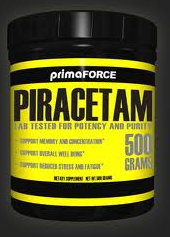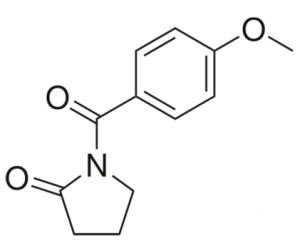
If you’ve read any of my blog posts so far or researched anything about nootropics on your own (I promise I won’t take offense if you do), you might have heard about racetams.
Honestly, no real conversation about nootropics can take place without including racetams at some point or another. So just in case you’ve heard of them but still aren’t quite sure what they are, or this is your first foray into nootropics, let me present my guide on the subject.
Welcome to Racetams 101.
Page Contents
What Are Racetams?

First thing’s first: What are racetams?
Well, that’s quite simple really. Racetams are a class of synthetic nootropics, cognitive enhancing drugs, grouped together because they share a similar chemical structure and, thus, similar bio-effects.
Racetams have a two-pyrrolidone nucleus made up of oxygen, hydrogen and nitrogen. You don’t really need to worry about that if you’re not science-minded (or interested). All you need to know is that they vary in terms of exact structure, potency, dosage and strength, but essentially affect the brain in similar ways based on their shared chemical backbone.
They are known for their abilities to make the brain work more effectively, essentially boosting memory, learning, focus, energy and mood–in addition to offering an overall boost to brain health.
The very first synthetic nootropic – and the substance that inspired researcher C.E. Giurgea to coin the term “nootropic” and conceptualize this category of cognitive enhancers in the first place – was Piracetam. All modern racetams now derive from Piracetam, though some are far more potent. Pramiracetam, for instance, may be as much as 30 times stronger than Piracetam.
As well as knowing what racetams are, it is also useful to understand what they are not.
They are not stimulants, for instance, and don’t aim to affect the stimulating neurotransmitters that often bring side effects such as anxiety, insomnia or the jitters. I bring this up only because racetams often get lumped in with other “smart drugs” (e.g. Adderall, Ritalin, Vyvanse, Modafinil, etc.) for their synthetic drug status.
Fortunately, the association is off.
How Do Racetams Work?

Most racetams work by affecting the production and degradation of the neurotransmitter acetylcholine.
Acetylcholine plays a powerful role in the brain, responsible for memory formation, attention and logical thinking, as well as other vital cognitive functions.
Needless to say, the Nootropic Geek has a lot of acetylcholine flowing through his brain.
*wink wink nudge nudge*
Certain racetams work by boosting the functioning of the acetylcholine receptors, while others improve the production of the neurotransmitter and/or impede the breakdown of acetylcholine. Each of these actions can vastly improve the body’s cholinergic system. Your brain takes choline and turns it into acetylcholine, and while scientists admit they don’t fully understand acetylcholine yet, they know enough to know that the brain uses it for everything from learning and focus to decision-making, memory and other cognitive activities.
Racetams also help to boost the amount of oxygen, glucose and nutrients travelling from your blood to the brain, giving your brain more fuel. Improved glucose metabolism helps to boost concentration, focus and mental energy.
By boosting acetylcholine and glucose metabolism, racetams are powerful tools to have in your nootropic arsenal.
The Best Racetams

There are 19 different racetams that have been discovered ever since the invention of Piracetam. Not all are nootropics; some are used for entirely different medical reasons. I’m particularly interested in five of them, the most popular racetams.
They are in alphabetical order:
- Aniracetam
- Oxiracetam
- Phenylpiracetam
- Piracetam
- Pramiracetam
I’m also going to add another supplement to this list: Noopept.
Although, it is not technically a racetam, Noopept works in a very similar way to Piracetam and is also very popular. Enough to be worthy of a mention.
While all of these racetams operate in a similar manner, they do have some structural differences, hence some are more potent than others, and certain racetams are better for particular uses. Some help to boost focus, others to help creativity, some stimulate (but not in the same way as a stimulant), while others calm or alleviate anxiety.
I’ll talk a little more about each racetam in turn, and discuss the research and share my own experiences of them. Take from it what you will, and note that my experience might not be your own.
Piracetam
 Piracetam, the very first nootropic drug, is still a popular choice by many, though it is mild compared to the racetams that came afterwards. It works well as an “entry level” drug for that reason, and is a good choice if you’re not used to nootropics. Piracetam works by stimulating the acetylcholine receptors to produce more of the vital neurotransmitter.
Piracetam, the very first nootropic drug, is still a popular choice by many, though it is mild compared to the racetams that came afterwards. It works well as an “entry level” drug for that reason, and is a good choice if you’re not used to nootropics. Piracetam works by stimulating the acetylcholine receptors to produce more of the vital neurotransmitter.
Research shows that the drug can boost cognitive function on several different fronts at the same time, specifically enhanced sensory perception, increased motivation and mental energy, and improved memory retention thanks to increased neuroplasticity. In trials, verbal memory significantly improved after 14 days on Piracetam.
Piracetam shows significant promise for patients with age-associated mental decline, but only moderate effects for healthy individuals. In my experience, you tend to notice a subtle benefit after a week or so of taking Piracetam instead of after a few hours, as you may experience with the stronger racetams.
Best Use: As a solid but mild cognitive enhancer base within a nootropic stack.
Dosage: I recommend starting at 800mg three times a day. Experienced users often go on to increase their dose to between one and three grams up to three times a day. You may need the larger amount because Piracetam is so mild. More on Piracetam.
Looking for Some Good Choline? Any nootropic stack worth its salt supplies a nootropic source of choline. As the building block of acetylcholine, the neurotransmitter involved in memory, learning, and high-order cognitive processes, choline is a big deal and fundamental component to boosting brain performance. To find a good source of nootropic choline, read my Best Nootropic Supplements to Buy in 2020 list here.
Aniracetam

Anecdotally, Aniracetam is said to be up to five times as potent as Piracetam. Yet, it takes longer for the body to break down Aniracetam, which is fat-soluble–meaning that its effects may last longer. It is thought to help communication between the two hemispheres in the brain, boost creativity and reduce anxiety in social situations, as well as improve focus.
Best Use: There’s a lot of discussion and anecdotal evidence on forums around the internet surrounding the use of Aniracetam for anxiety. While human trials are lacking, it seems as if it has strong anxiolytic properties. More on Nootropics for Anxiety
Aniracetam is also a good “step up” drug from Piracetam for those who think the latter is too mild.
Dosage: A typical dose is approximately 750mg (some people recommend anywhere between 600-3,000mg a day), taken one to three times a day with food. Aniracetam’s short half-life (up to two hours) means that it is best taken frequently to keep up the benefits. Again, supplement with choline to avoid headaches. Aniracetam needs to be taken with fatty acids as it is fat-soluble and will not dissolve in water.
Note: According to reports, sensitive people may find the anxiolytic properties in Aniracetam (fighting anxiety) a little too effective, and begin to feel unmotivated and/or sedated. I don’t know about you, but I tend to do my worst work when I’m asleep.
Oxiracetam

Considered one of the most expensive racetams, Oxiracetam is faster acting than both Piracetam and Aniracetam, so you can get away with supplementing smaller doses. It differs to the other racetams in that it is one of the few that acts as a stimulant, though in a different way than true stimulants (e.g. caffeine).
Oxiracetam’s stimulation seems to hinge on the release of excitatory neurotransmitters, potentially aiding memory formation. Yet, I’d like to see the human research before labeling this all down as the “Truth.”
Users praise Oxiracetam for its ability to boost cognition and memory, as well as its contribution to logic-based thinking. Interestingly, Oxiracetam seems to improve spatial memory and help you grasp abstract concepts.
Best Use: Oxiracetam is thought to be especially useful for analytical and logic-based thinking, helping the brain to perform computations easier, so is ideal for anyone studying mathematics or number-based subjects. If this sounds too abstract to be true, you’re not alone there. Yet, I lend credence to Oxiracetam’s association with logical thinking, considering this association is almost unanimous with the nootropic.
Dosage: Recommended dosage is 700 mg to 2,400mg a day; although, new users should start with the lower dose and build up. Best to take one hour before you need to do any mentally exhausting work, or every six to eight hours when studying.
Note: It is best to use Oxiracetam for a short period of time, just when you need it.
Phenylpiracetam

Arguably the most modified racetam available, Phenylpiracetam has a similar chemical structure to Piracetam with an added phenyl group molecule, which massively increases the molecule’s bio-availability.
The consequence of this is that Phenylpiracetam works much quicker and its effects potentially last longer than any other racetam. You can use a smaller dosage as well.
Fans of Phenylpiracetam say that it improves productivity and memory, while giving a powerful boost to focus and energy without a crash or the jitters.
Best Use: For all the reasons mentioned above, Phenylpiracetam is particular popular among college students or anyone who needs a helping hand in a competitive business environment.
Dosage: If you are new to Phenylpiracetam, start with a low dose of 100mg a day. You can gradually increase it as your body becomes used to the substance.
WADA Banned Phenylpiracetam
 Take caution with Phenylpiracetam if you’re a competitive athlete, because this compound is banned by the World Anti-Doping Agency. And by “Take caution” I mean “Don’t take at all.” Phenylpiracetam is so bio-active that it’s stimulatory effects are believed to offer a genuine unfair advantage in sport. Recreational users on the other hand should take actual caution, considering that this nootropic is much more potent than many other “safe” nootropic racetams.
Take caution with Phenylpiracetam if you’re a competitive athlete, because this compound is banned by the World Anti-Doping Agency. And by “Take caution” I mean “Don’t take at all.” Phenylpiracetam is so bio-active that it’s stimulatory effects are believed to offer a genuine unfair advantage in sport. Recreational users on the other hand should take actual caution, considering that this nootropic is much more potent than many other “safe” nootropic racetams.
Pramiracetam

Talkin’ about potency: Pramiracetam is THE premium racetam, believed to be up to 30 times stronger than Piracetam and the strongest racetam of them all.
¡Ay Dios mio!
It helps to boost energy levels and gives increased alertness up to 10 hours after taking. It’s a great productivity supplement, helping to improve multiple cognitive elements and boost focus and memory. Users report that it offers clarity of thought, less likelihood of being distracted and less ‘chatter’ in the brain.
I found myself zoned in and able to ignore pretty much all distractions for an intensely long period of time–minus the jaw-clenching side effects of, say, Adderall.
Animal studies found that it increases high affinity choline uptake, presumably partially responsible for its cognitive enhancing effects, and increases blood flow to the brain.
Further animal studies suggest that it helps with long-term memory formation and human studies support this, though there are currently no human trials investigating Pramiracetam’s cognitive enhancing effects on healthy young people.
Best Use: You’ll often find it included with other nootropics or other racetams in a stack as Pramiracetam helps to enhance the effects of other drugs and supplements.
Dosage: As Pramiracetam is so concentrated, you will only need a smaller dose. The recommended dose is either 400mg taken three times a day, or 600mg twice a day.
Note: Compared to the other racetams, Pramiracetam is largely understudied but does have some human evidence. Even so, given its potency, I’d like to see more human trials on this racetam before considering it for long-term consumption.
Noopept
As I mentioned above, Noopept is not technically a racetam as it has a different chemical structure, but it does work in a similar way and is commonly confused for one, so it’s worth a brief mention.
Noopept provides a mild cognitive boost after taking, which can also come with a subtle psychostimulatory effect. If I had to sum up the experience: Noopept is essentially the Piracetam experience, but all at once–minus the “waiting period” prior to Piracetam’s effects.
Research shows that it has a neuroprotective benefit during cognitive trauma (physical or otherwise), though more research is needed to discover exactly how it does this. The one human study comparing Noopept and Piracetam suggest that both are comparable once Noopept’s much smaller dose (10-30mg once a day) is taken into account.
Dosage: 10-30mg once a day for no more than 56 days at any one time.
Note: Some people would argue that Noopept’s psychostimulatory effect isn’t all that subtle. Out of all the racetams, this is the drug where you may feel the biggest departure from a “normal” mental state. As such, take genuine caution with this nootropic. Start low and build up to an appropriate dosage. More on Noopept.
